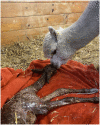Birth of a Live Cria After Transfer of a Vitrified-Warmed Alpaca (Vicugna pacos) Preimplantation Embryo
- PMID: 33344527
- PMCID: PMC7744456
- DOI: 10.3389/fvets.2020.581877
Birth of a Live Cria After Transfer of a Vitrified-Warmed Alpaca (Vicugna pacos) Preimplantation Embryo
Abstract
The alpaca (Vicugna pacos) is an important species for the production of fiber and food. Genetic improvement programs for alpacas have been hindered, however, by the lack of field-practical techniques for artificial insemination and embryo transfer. In particular, successful techniques for the cryopreservation of alpaca preimplantation embryos have not been reported previously. The objective of this study was to develop a field-practical and efficacious technique for cryopreservation of alpaca preimplantation embryos using a modification of a vitrification protocol originally devised for horses and adapted for dromedary camels. Four naturally cycling non-superovulated Huacaya females serving as embryo donors were mated to males of proven fertility. Donors received 30 μg of gonadorelin at the time of breeding, and embryos were non-surgically recovered 7 days after mating. Recovered embryos (n = 4) were placed individually through a series of three vitrification solutions at 20°C (VS1: 1.4 M glycerol; VS2: 1.4 M glycerol + 3.6 M ethylene glycol; VS3: 3.4 M glycerol + 4.6 M ethylene glycol) before loading into an open-pulled straw (OPS) and plunging directly into liquid nitrogen for storage. At warming, each individual embryo was sequentially placed through warming solutions (WS1: 0.5 M galactose at 37°C; WS2: 0.25 M galactose at 20°C), and warmed embryos were incubated at 37°C in 5% CO2 in humidified air for 20-22 h in 1 ml Syngro® holding medium supplemented with 10% (v/v) alpaca serum to perform an initial in vitro assessment of post-warming viability. Embryos whose diameter increased during culture (n = 2) were transferred individually into synchronous recipients, whereas embryos that did not grow (n = 2) were transferred together into a single recipient to perform an in vivo assessment of post-warming viability. Initial pregnancy detection was performed ultrasonographically 29 days post-transfer when fetal heartbeat could be detected, and one of three recipients was pregnant (25% embryo survival rate). On November 13, 2019, the one pregnant recipient delivered what is believed to be the world's first cria produced from a vitrified-warmed alpaca embryo.
Keywords: South American camelid; cryopreservation; galactose; hatched blastocyst; vitrification.
Copyright © 2020 Lutz, Johnson, Duprey, Taylor, Vivanco-Mackie, Ponce-Salazar, Miguel-Gonzales and Youngs.
Conflict of interest statement
The authors declare that this research was financed by and conducted at Cas-Cad-Nac Farm. JL, SJ, and KD are affiliated with or employed by Cas-Cad-Nac Farms. PT is affiliated with GeneSearch, Inc. HV-M, DP-S, and MM-G are affiliated with or employed by Vivanco International SAC. Although these results directly benefit Cas-Cad-Nac Farm, GeneSearch, Inc, and Vivanco International SAC, these results also benefit alpaca breeders throughout the world because they are being published in an open access journal. The remaining author declares that the research was conducted in the absence of any commercial or financial relationships that could be construed as a potential conflict of interest.
Figures



Similar articles
-
Successful pregnancies from vitrified embryos in the dromedary camel: Avoidance of a possible toxic effect of sucrose on embryos.Anim Reprod Sci. 2017 Dec;187:116-123. doi: 10.1016/j.anireprosci.2017.10.015. Epub 2017 Oct 26. Anim Reprod Sci. 2017. PMID: 29110898
-
Effect of warming method on embryo quality in a simplified equine embryo vitrification system.Theriogenology. 2020 Jul 15;151:151-158. doi: 10.1016/j.theriogenology.2020.03.012. Epub 2020 Mar 19. Theriogenology. 2020. PMID: 32361181
-
Successful vitrification of dromedary camel embryos using a novel embryo vitrification kit.Anim Reprod Sci. 2020 Jul;218:106483. doi: 10.1016/j.anireprosci.2020.106483. Epub 2020 May 6. Anim Reprod Sci. 2020. PMID: 32507263
-
Survival of vitrified in vitro-produced bovine embryos after a one-step warming in-straw cryoprotectant dilution procedure.Theriogenology. 2015 Mar 15;83(5):881-90. doi: 10.1016/j.theriogenology.2014.11.021. Epub 2014 Nov 26. Theriogenology. 2015. PMID: 25542458
-
Current status and future direction of cryopreservation of camelid embryos.Theriogenology. 2017 Feb;89:20-25. doi: 10.1016/j.theriogenology.2016.10.005. Epub 2016 Oct 13. Theriogenology. 2017. PMID: 28043352 Free PMC article. Review.
Cited by
-
New Alternative Mixtures of Cryoprotectants for Equine Immature Oocyte Vitrification.Animals (Basel). 2021 Oct 28;11(11):3077. doi: 10.3390/ani11113077. Animals (Basel). 2021. PMID: 34827809 Free PMC article.
-
Oocyte Quality, In Vitro Fertilization and Embryo Development of Alpaca Oocytes Collected by Ultrasound-Guided Follicular Aspiration or from Slaughterhouse Ovaries.Animals (Basel). 2022 Apr 25;12(9):1102. doi: 10.3390/ani12091102. Animals (Basel). 2022. PMID: 35565530 Free PMC article.
References
-
- FAOSTAT (2018). Available online at: http://www.fao.org/faostat/en/#data/QA (accessed October 13, 2020).
-
- Haudry De Soucy R. Investing in the development of South American campesino camelid economies: the experience of the international fund for agricultural development (IFAD). In: Pérez-Cabal MÁ, Gutiérrez JP, Cervantes I, Alcalde MJ, editors. Fibre Production in South American Camelids and Other Fibre Animals. Wageningen Academic Publishers: Wageningen: (2011) 195–99. 10.3920/978-90-8686-727-1_25 - DOI
-
- Stuart CC, Bathgate R. Advancing assisted reproductive technologies in camelids (especially the alpaca). Rural Industries Research & Development Corporation Publication Number 15/067. (2015). p. 36. - PubMed
LinkOut - more resources
Full Text Sources

